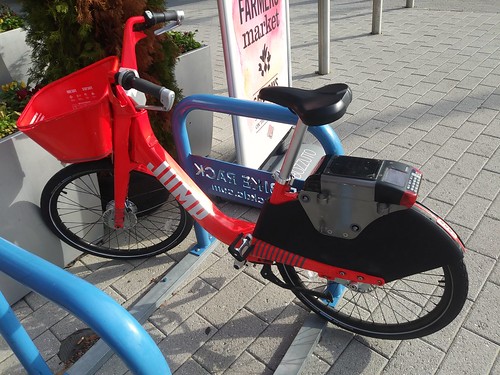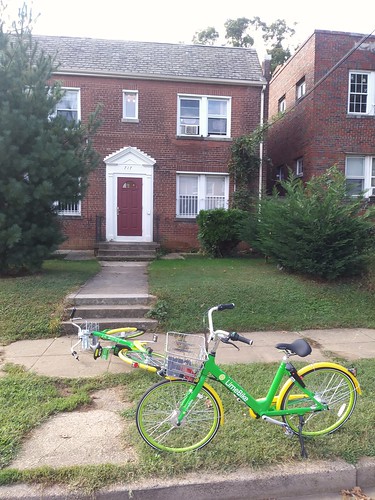Micromobility is not a suburban phenomenon: or Chinese cities are different from American suburbs
 I am confident these people are tourists.
I am confident these people are tourists.There is an opnion piece ("Is American Micromobility A Bust?") in Wired making the point that while the business of micromobility in the guise of scooters and e-bikes may crash and burn, based on the experience in China with e-bikes, likely over time, the position of micromodes will become firmly established in the American mobility system. From the article:
In recent months, safety concerns and deep operating losses have cast doubt on the long-term prospects of the electric scooter and bike-share industry. American mobility networks like Lime and Bird are devouring so many ebikes and scooters that even Chinese manufacturers worry their pace is unsustainable.
But while individual companies may struggle, such micromobility isn't doomed. For proof, we need only look to China, which already has roughly 200 million electric bicycles and scooters on its streets. If American cities can make space for electric scooters and bicycles, they can incubate technologies that will change the face of urban transportation. …
The industry will spawn new business models, software platforms, subscription fees, and product ecosystems. All this will enable increased productivity, a reduction in emissions and air pollution, and massive savings in time and fuel.
Just as we have come to rely on telecommunications, we all rely on mobility. In many cases, micro will be the best way to supply this demand. This is as true in car-crazy America, where roughly 60 percent of car trips are under 6 miles long...
 Absolutely there is an important role for micromobility in the US transportation system, especially if bikes (and e-bikes) are being "redefined" as "micromobility.
Absolutely there is an important role for micromobility in the US transportation system, especially if bikes (and e-bikes) are being "redefined" as "micromobility.But the reality is that the US transportation planning paradigm is so dominated by automobility that biking (and transit) comprises an almost infinitesimal percentage of total trips--something like 96% of all trips involve an automobile.
Technology-led innovation doesn't always succeed. That doesn't mean micromodes aren't viable, only that technology-led "innovation" often isn't enough to induce substantive changes in behavior necessarily.
A good example is "the Segway," which did not revolutionize transportation although such was touted ("WELL, THAT DIDN'T WORK: THE SEGWAY IS A TECHNOLOGICAL MARVEL. TOO BAD IT DOESN'T MAKE ANY SENSE," Wired Magazine), although to be fair, it did help pave the way for the creation of e-scooters. According to this article, "A Lesson in Innovation: Why did the Segway fail?," there are evident lessons:
1. Expectations were too high. The Segway was described as the future of transport. As an innovation it was said to be on a par with the PC or the internet. Inevitably it could not live up to this level of hype. PR exposure is generally useful but this time it was overdone.
2. It was a product not a solution. The product works well but it lacked a support context. Where can you park it? How do you charge it? Do you use it on roads or sidewalks? Our cities are designed for pedestrians or speedy vehicles and this was neither so it had no proper infrastructure to support it.
3. No clear need or target market. Who was the target market? Who really needed this? It was an appealing novelty but there was no compelling need for anyone to buy it – and it was very expensive.
4. It was an invention rather than an innovation. The Segway was patented and kept under wraps until its launch. There was no user feedback or iteration in the process. Its inventors were then surprised when people criticised or ridiculed the design for being ‘dorky’ rather than cool.
5. Regulation. The Segway fell foul of regulation in many countries where it was banned from sidewalks and roads because it did not fit any existing categories. This is a problem for a truly revolutionary product – but it was not properly anticipated.Note that using this evaluative framework, e-scooters have more going for them than the Segway. It's cheaper. It can be a solution, although maintaining the product-service system is more complicated and more expensive than expected, and vandalism is high. There is a target market.
But people's understanding of the "market" isn't nuanced such as differentiating between cities and suburbs and there is strong possibility that the market of actual users is too small to make the business profitable for multiple for profit actors, even one.
In cities like Washington more than 50% of work trips are completed using sustainable modes (not the automobile). In suburbs, the number of commute trips completed using sustainable modes minimal by comparisonl ("How Suburban Are Big American Cities?," 538; "The US has become a nation of suburbs," The Conversation).
It might end up that scooters get incorporated into traditional dock-focused bike sharing systems, which are mostly run by governments or nonprofits, because subsidy ends up being required, as an element of a complete mobility system.
As it is, some of the companies are now testing docks ("E-scooter startup Spin will place dozens of solar powered docking stations in two cities this summer," Washington Post) in response to complaints about how scooters are often "discarded" wantonly in the public space.
The way these scooters were placed next to a bike sharing station on Independence Avenue NW indicates it wouldn't be too hard to integrate scooters into dock-based bike share.

Is China the right place for the US to learn about the applicability of micromodes? Like how I aver that the e-scooter business learned the wrong lesson from Santa Monica--it's a beach town and in beach towns people bike and are willing to use scooters ("What the e-scooter industry hasn't figured out about Santa Monica: It's recreation not transportation")--in terms of both land use organization and center city population, China is not analogous to the US experience.
The US has 11 cities with over 1 million population. China has more than 160.
The US form of suburban focused development--deconcentrated and disconnected uses spread out over long distances, connected by automobile--is not amenable to certain types of micromodes--bikes yes, scooters no--and does not typify land use form in China.

Plus most of the people using e-bikes in places like China switched from either not owning a vehicle or owning a gasoline-power motorbike. They did not "downgrade" to an e-bike from an automobile.
About half of the US cities with populations greater than 1 million have what Peter Muller calls a "metropolitan" form as opposed to the "Walking City" or "Transit City" form.
-- "Transportation and Urban Form: Stages in the Spatial Evolution of the American Metropolis"
Walking and Transit Cities are supportive of sustainable mobility ("DC is a market leader in mobility as a service (MaaS)"). Metropolitan cities like Phoenix, Austin, or Houston are more suburban in form, as are the nation's suburban counties. Achieving success with sustainable mobility modes in suburban settings is a struggle.
The distance of the average trip is much longer, and today's attitudes and behaviors of the average person do not support the regular choice of sustainable modes.
 For me, the biggest thing that dockless bike share proved is that access to a bike is not the primary impediment to people taking up biking for transportation.
For me, the biggest thing that dockless bike share proved is that access to a bike is not the primary impediment to people taking up biking for transportation. There were plenty of dockless bikes deployed during the heyday of the launch period of the services.
They didn't get used all that much. And probably a majority of the trips were for recreation.
Granted it's a different story for e-bikes. But for many years, I've argued there is a place for e-bikes in the mobility system.
But ironically, not so much in the core of center cities as the outskirts and inner suburbs, and for seniors ("Still tired of the misunderstanding of the potential for e-bikes").
=====
Sit down scooter (often referred to as a moped) share has been launched in NYC ("Revel's mopeds are a fun ride around Brooklyn and Queens," The Verge). It has been offered in San Francisco for a few years, and in Paris more recently.
Again, in the core of the center city, these vehicles are probably overkill, like e-bikes.
But there is a place for them in the mobility system ("Further updates to the sustainable mobility framework"), just as there is for e-bikes, scooters and other e-conveyances, and traditional bicycles, but not pogo sticks ("Shareable pogo sticks: an indicator that micromobility has "jumped the shark" | Pedestrian Road Design/Signature Streets").
Labels: bicycle and pedestrian planning, micromobility, mobility as a service (MaaS), sustainable mobility platform, transportation planning, urban design/placemaking, urban vs. suburban vs. rural





0 Comments:
Post a Comment
<< Home